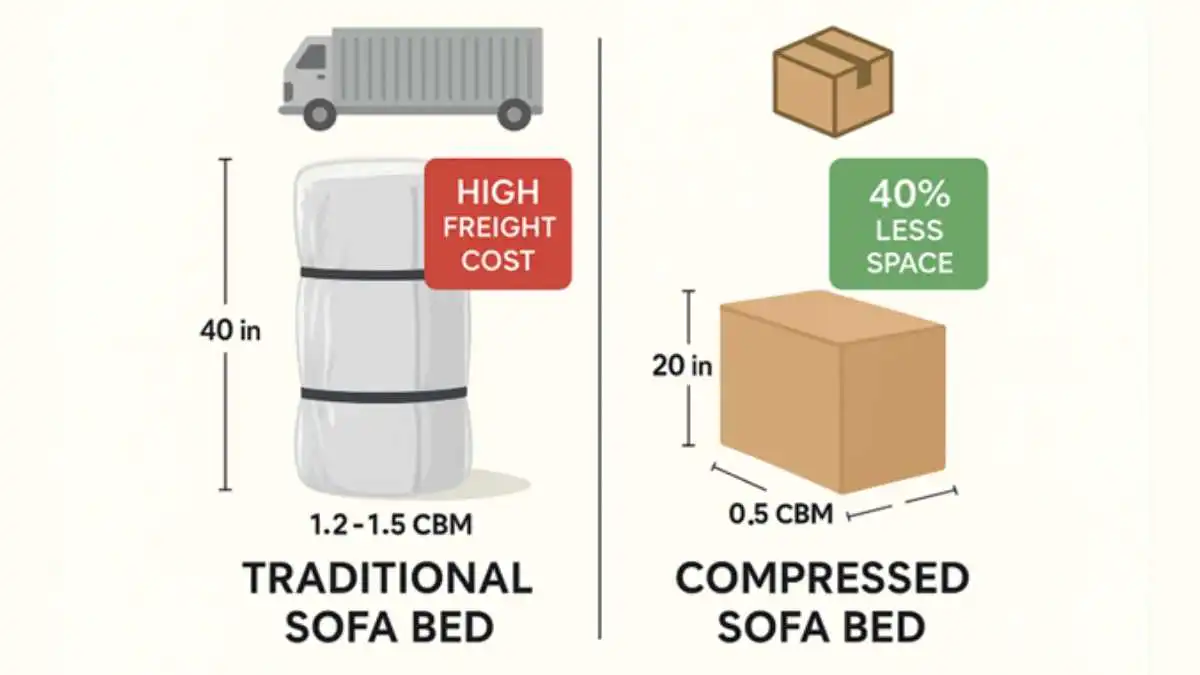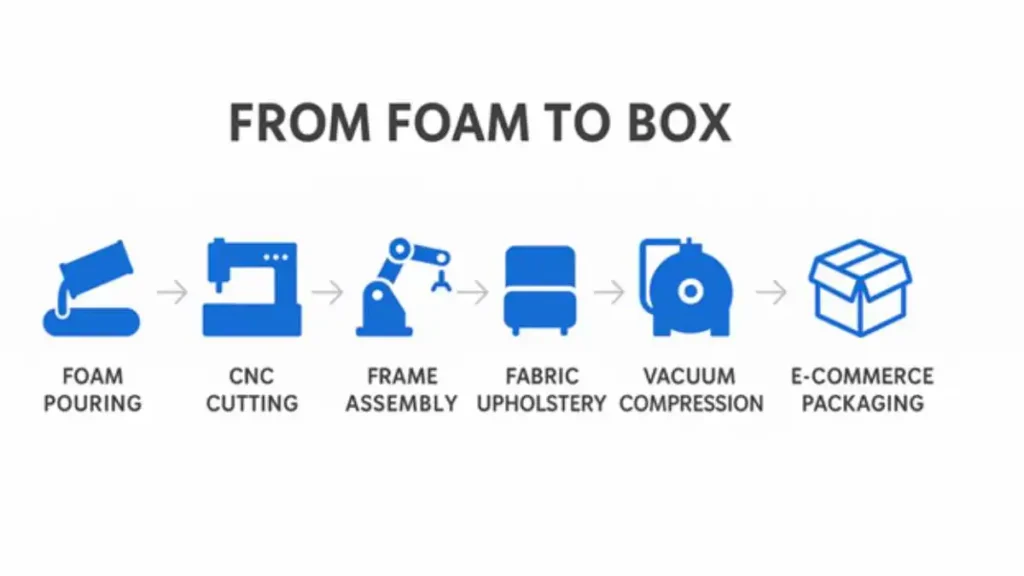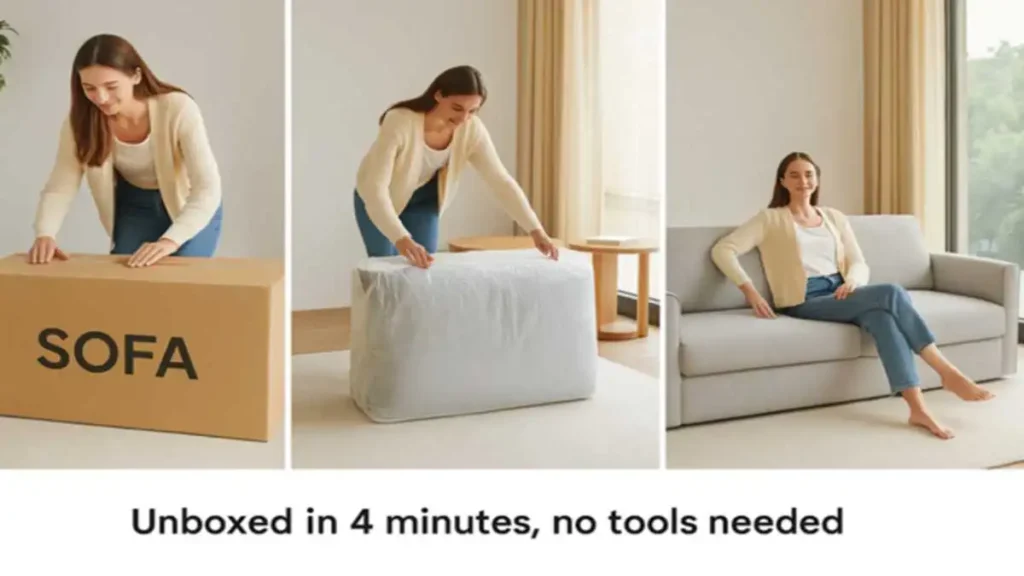GENERAL
From Factory to Box: Compressed Sofa Beds Save You More

Compressed Sofa Bed: A Smarter Product for Smarter Shipping
Many e-commerce furniture brands face the same challenge when launching sofa beds: high freight costs, oversized packaging, and fragile shipping performance. These pain points have created a growing demand for a smarter, logistics-optimized alternative—compressed sofa beds.
Unlike traditional sofa beds, compressed models are engineered to be vacuum-packed, tightly rolled, or folded flat. Once unpacked, they expand into full-size furniture suitable for modern living spaces. No oversized freight charges. No white-glove assembly. Just efficient design that reduces costs, saves warehouse space, and delivers better customer experience.
For fast-growing DTC startups and global OEM brands alike, compressed sofa beds offer a powerful combination of practicality, scalability, and fulfillment efficiency—especially in a market where shipping costs and delivery experience directly impact margins.
Table of Contents
Real Benefits for Brands: Save on Storage, Shipping & Returns
For e-commerce brands, logistics isn’t just a backend process, it’s a strategic differentiator. Compressed sofa beds are a direct response to this reality.
By design, a traditionally packaged sofa bed might occupy 1.2 to 1.5 CBM. A compression-optimized model can reduce that volume to as little as 0.5 CBM, cutting freight costs by up to 40%, especially in containerized sea shipments. This allows businesses to store more units per container or pallet and reduce per-unit landed cost.
Smaller packaging also improves warehouse utilization. In 3PL environments that charge by pallet or cubic meter, compressed units allow for tighter stacking and more efficient use of space—lowering overhead without changing SKUs.
Returns are also less painful. Many compressed models can be partially re-packed and returned using small-parcel carriers. This reduces the need for costly freight pickups and improves reverse logistics flow—critical for DTC brands where return rates in home categories can exceed 15%.
Compressed sofa beds aren’t just efficient to ship—they’re easier to store, easier to handle, and easier to scale.
How Compression Manufacturing Actually Works
Behind every compact carton is a precise production system designed for compression and shipping intelligence.
It starts with foam selection. High-resilience polyurethane or memory foam is used—designed to rebound after compression without long-term deformation. Foam blocks are CNC-cut to millimeter precision for consistent fitness and firmness across batches.
Frames are modular and foldable, often made from lightweight steel or engineered board. These structures enable folding or rolling for packaging while maintaining strength and user comfort after deployment.

The final compression step involves industrial-grade vacuum systems and compression presses. Sofas are wrapped, sealed, and packed in cartons designed for drop testing and courier handling. A well-executed product can shrink by 50–60% of its expanded volume and still decompress fully in minutes after unboxing.
Compression manufacturing is not just about squeezing space—it’s about engineering every step of the product lifecycle for cross-border efficiency.
Inside a Compression Sofa Factory: What Really Matters to Buyers
Choosing the right compression sofa factory can make or break a product launch. Not all furniture manufacturers are equipped to produce compressed sofa beds on a scale.
At a dedicated compression sofa factory like UWinfoam, production begins with foam pouring lines that generate over 90m³ of polyurethane foam daily. This foam is formulated to match each client’s density, rebound, and durability specs.
Automated CNC systems, fabric lamination lines, and modular assembly stations allow the factory to turn raw foam into furniture-ready SKUs with minimal variation. These systems also ensure consistent output across global orders.
But what sets a compression-ready factory apart is its packaging infrastructure. With in-house vacuum chambers, compression rigs, and e-commerce-grade packing lines, each sofa is prepped for container loading or direct parcel fulfillment.
Certifications matter too. UWinfoam’s facility is ISO 9001 certified, and complies with CertiPUR-US, OEKO-TEX Standard 100, and BSCI standards, meeting the quality, safety, and ethical sourcing benchmarks of leading platforms like Amazon and Wayfair.
How to Choose the Right OEM Compression Sofa Supplier
Compressed sofa beds require more than standard upholstery skills. They demand packaging foresight, process control, and platform-specific compliance. Here’s what experienced buyers look for:
- Compression capability, not just foam output: Can the factory design for compact packaging and long-term resilience?
- Material flexibility: Do they support varied foam densities, fabrics, and finishes? Can they customize for seasonality or market trends?
- Sampling & low MOQ support: Can you test before you commit? Factories like UWinfoam offer prototyping and low minimums to accelerate go-to-market cycles.
- Platform-compliant packaging: Are boxes ISTA-certified and drop-test ready? Are carton sizes optimized for FBA or international 3PLs?
- Certifications: ISO 9001, CertiPUR-US, OEKO-TEX, and social audits are must-haves—not checkboxes.
The right supplier doesn’t just do what you ask, they anticipate what your supply chain demands.
Real Brand Story: From First Sample to First Sales
In early 2024, a European DTC home brand was struggling to find a scalable sofa bed solution. Their core product—an upholstered pull-out sofa—was bulky, expensive to ship, and prone to damage during last-mile delivery.
They partnered with UWinfoam to develop a compressed foam-based 3-seater sofa bed, designed for “sofa-in-a-box” e-commerce.
Week 1–3: UWinfoam provided two free samples with different foam densities and modular layouts. Final compression volume: 0.52 CBM, down from the brand’s previous 1.28 CBM per unit.
Week 4–6: The brand tested various carton designs. Final packaging passed ISTA-3A tests for Amazon FBA compliance. Assembly time post-unboxing: under 4 minutes. No tools required.
Week 7–8: First batch of 100 units shipped within 18 days. Listed on Shopify and Amazon EU, the SKU sold out within 30 days, generating €48,000+ in revenue with an average 4.6-star rating.
With early success and reduced returns (under 4%), the brand expanded into two more variants: a loveseat and a storage ottoman—both compression-ready.

Ready to Test or Launch Your Compressed Sofa Line?
Compressed sofa beds are no longer niche—they’re a strategic upgrade for brands that want to move faster, ship smarter, and unlock new margin potential.
If you’re testing a new category, refining last-mile efficiency, or scaling a furniture line globally, now’s the time to explore compression manufacturing.
Look for a partner that can offer sampling, low-MOQ production, logistics-friendly design, and certified packaging—all under one roof. Your next bestseller might be sitting flat-packed in a box—ready to ship, ready to scale, and ready to grow your brand.
-

 GENERAL5 months ago
GENERAL5 months agoChristofle – For Those Who Dream of Family Heirloom Silver
-

 SPORTS7 months ago
SPORTS7 months agoDiscover the World of Football with Streameast: Watch Your Favorite Leagues and Tournaments
-

 GENERAL4 months ago
GENERAL4 months agoUncovering the World of кинокрадко: The Dark Side of Film Piracy
-

 GENERAL1 month ago
GENERAL1 month agoATFBooru: Anime, Gaming, and Subculture Imageboard





























